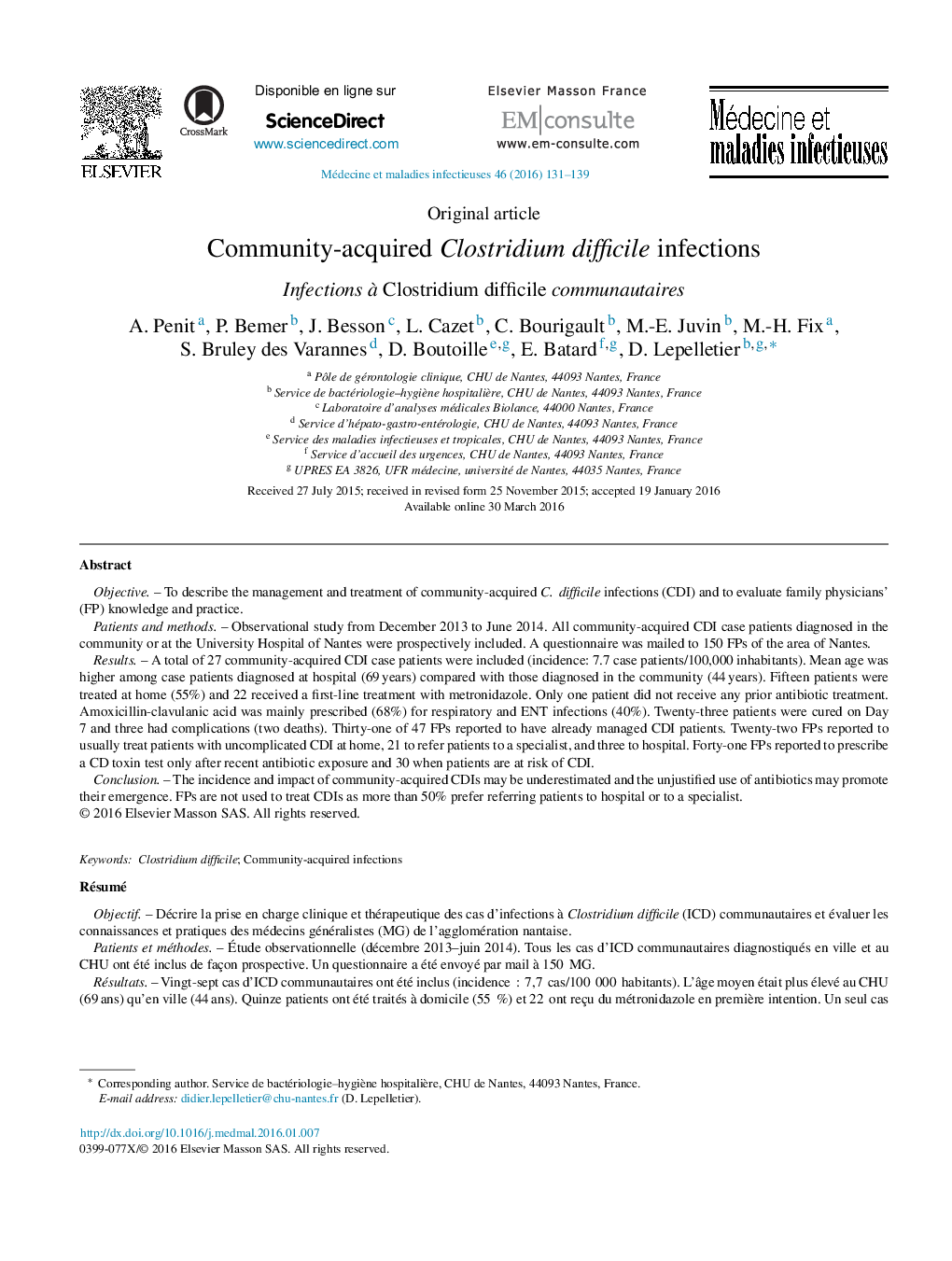| کد مقاله | کد نشریه | سال انتشار | مقاله انگلیسی | نسخه تمام متن |
|---|---|---|---|---|
| 3412258 | 1224218 | 2016 | 9 صفحه PDF | دانلود رایگان |

ObjectiveTo describe the management and treatment of community-acquired C. difficile infections (CDI) and to evaluate family physicians’ (FP) knowledge and practice.Patients and methodsObservational study from December 2013 to June 2014. All community-acquired CDI case patients diagnosed in the community or at the University Hospital of Nantes were prospectively included. A questionnaire was mailed to 150 FPs of the area of Nantes.ResultsA total of 27 community-acquired CDI case patients were included (incidence: 7.7 case patients/100,000 inhabitants). Mean age was higher among case patients diagnosed at hospital (69 years) compared with those diagnosed in the community (44 years). Fifteen patients were treated at home (55%) and 22 received a first-line treatment with metronidazole. Only one patient did not receive any prior antibiotic treatment. Amoxicillin-clavulanic acid was mainly prescribed (68%) for respiratory and ENT infections (40%). Twenty-three patients were cured on Day 7 and three had complications (two deaths). Thirty-one of 47 FPs reported to have already managed CDI patients. Twenty-two FPs reported to usually treat patients with uncomplicated CDI at home, 21 to refer patients to a specialist, and three to hospital. Forty-one FPs reported to prescribe a CD toxin test only after recent antibiotic exposure and 30 when patients are at risk of CDI.ConclusionThe incidence and impact of community-acquired CDIs may be underestimated and the unjustified use of antibiotics may promote their emergence. FPs are not used to treat CDIs as more than 50% prefer referring patients to hospital or to a specialist.
RésuméObjectifDécrire la prise en charge clinique et thérapeutique des cas d’infections à Clostridium difficile (ICD) communautaires et évaluer les connaissances et pratiques des médecins généralistes (MG) de l’agglomération nantaise.Patients et méthodesÉtude observationnelle (décembre 2013–juin 2014). Tous les cas d’ICD communautaires diagnostiqués en ville et au CHU ont été inclus de façon prospective. Un questionnaire a été envoyé par mail à 150 MG.RésultatsVingt-sept cas d’ICD communautaires ont été inclus (incidence : 7,7 cas/100 000 habitants). L’âge moyen était plus élevé au CHU (69 ans) qu’en ville (44 ans). Quinze patients ont été traités à domicile (55 %) et 22 ont reçu du métronidazole en première intention. Un seul cas n’avait reçu aucun antibiotique au préalable. L’amoxicilline-acide clavulanique était l’antibiotique le plus prescrit (68 %) pour des infections ORL et respiratoires (40 %). Vingt-trois cas étaient guéris au 7e jour et trois présentaient des complications (deux décès). PArmi les MG, 31/47 avaient déjà été confrontés à une ICD. En cas de forme simple, 22 MG déclaraient traiter les malades à domicile, 21 les adresser à un spécialiste et trois à l’hôpital. Quarante et un MG déclaraient prescrire une recherche de toxine lors d’une antibiothérapie récente et 30 devant un terrain à risque.ConclusionLes ICD communautaires pourraient être sous-estimées et l’utilisation non justifiée d’antibiotiques pourrait favoriser leur émergence. La prise en charge des ICD par les MG n’est pas optimale car > 50 % d’entre eux préfèrent les adresser à l’hôpital ou à un spécialiste.
Journal: Médecine et Maladies Infectieuses - Volume 46, Issue 3, May 2016, Pages 131–139